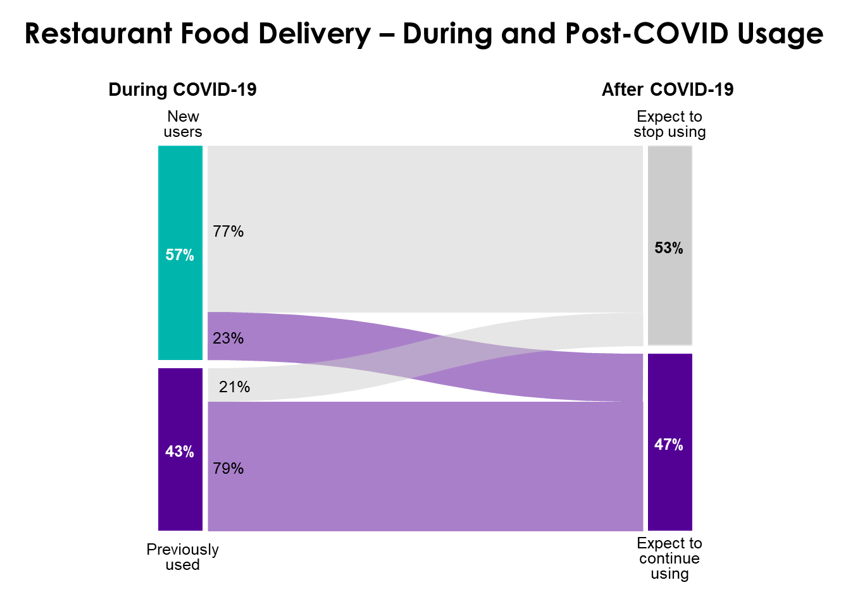
The pandemic is testing our ability to adapt. We were just getting used to our new normal—including Zoom happy hours, bad haircuts, and social distancing strategies—when states began to open back up, and, in some cases, close down again. We just might have to get used to this cycle. We are all flexing and pivoting to meet the moment as we pay close attention to the data, determining the best course of action to take on a weekly—or even daily—basis.
No one knows exactly how long this will go on but there is a general eagerness to return to life as it was pre-pandemic. What will that life look like? How can we get through these challenging, rapidly evolving times and prepare for life post-coronavirus? Escalent conducted a study to understand what consumers anticipate and envision in a post-COVID-19 world.
One thing we can be certain of is the way we get our food fundamentally changed during shelter-in-place—notably, across two categories: Restaurant Food Delivery and Meal Kit Delivery.
Restaurant Food Delivery
Before states started opening back up, 57% of restaurant food delivery users were new users. Under normal circumstances, such a sizable influx of new users would be unbelievable, but with the forced change in behavior consumers had to make while sheltering-in-place, it makes sense. What is particularly interesting to see is this influx of new users is not necessarily here to stay: a large majority (77% of new users) don’t plan to use restaurant food delivery services in a post-COVID-19 world—and while a portion of consumers who used restaurant delivery before the pandemic aren’t leaving in droves, some (21%) don’t plan to have restaurant food delivered again. This is not to say these customers are lost forevermore but they could be if the services don’t intervene to improve the customer experience.

This may be good news for restaurants given the tenuous relationship they have with delivery services, but delivery services have some investigating to do if they want to establish a sustainable place in the market. Our findings, like any good research, create several lines of inquiry:
- Why don’t new users plan to use these services when we are no longer living with a pandemic threat?
- Did restaurant delivery services sorely disappoint consumers as they struggled to scale up to meet the surge in demand while relying on gig economy workers?
- Or, do we deeply miss the experience of dining in a restaurant that much?
I know I’m eager for a change of scenery and, now that many home and work environments have become one, I’m sure I’m not alone. It will be critical for delivery services to gain a deeper understanding of consumers’ pain points and determine how they can improve the customer experience. Further research on the topic can identify the crux and craft strategies to increase loyalty in this sector.
Meal Kit Delivery
While meal kit subscriptions remained a niche behavior during the shutdown, an astonishing three out of every four users were new. This is colossal, considering a few years ago Blue Apron was under fire for spending big to acquire new customers. That said, the uptick appears to be at risk of becoming a flash in the pan, as most new users (85%) don’t plan to continue using the service once the pandemic is fully in the rearview mirror, ultimately resulting in a modest uptick (15%) in users. Similar to restaurant delivery, we do see some existing users who also plan to discontinue meal kits.

This is an interesting category to consider when pondering why consumers aren’t sticking with this service. Sheltering-in-place means many of us have a lot more time on our hands, which has led to an increase in cooking and baking (and dish washing). I shudder to think about all of the sourdough starters that will end up in the garbage in the coming months. Once we resume our busy lives, does that mean we’ll have less time to cook the type of meals these kits provide?
Perhaps the better question is: where and why do these kits fail to keep the interest for the burgeoning in-home chef? There are many factors unique to the pandemic that may have impacted these services—such as the sudden influx in demand and shipping delays resulting in food being delivered past its prime. What can meal providers do to improve their offering and delight customers with a fabulous and lasting experience?
Now What?
We must remember that change is hard, and we are living through an extraordinary period of challenges that requires constant adaptation. It is human nature to want what is familiar and comfortable, stable and secure. So, even if these services were a convenience or a priceless lifeline during these trying times, there is a palpable desire to get our old lives back—even all the inconveniences that went along with them.
However, it is hard to know what will happen next or when. This can raise more questions than answers, which is why it is critical to stay in tune with what consumers are thinking, feeling, and doing. Did consumers envision that life would go back to normal after confinement? Did they expect to resume their usual pre-pandemic habits and behaviors once the economy started opening up again? How will their behaviors and expectations continue to change as we experience additional waves of infection? Is it possible that they become more loyal, long-term users if we live with the risk of COVID-19 for the remainder of 2020 and beyond?
Many states are trying to get back to normal, but others are applying or reapplying restrictions. As the companies in the restaurant food delivery and meal kit delivery industries adapt to daily changes and challenges, they need to remain forward-looking and ask themselves: “Now what?” They’ve had a huge influx of customers and many don’t plan to stay so they need to consider how to address this.
- What were possible pain points that may have pushed customers away?
- How, if at all, can these services better fit into consumers’ “normal lives”?
- What can providers do to improve their offering and customer experience so users want to keep their services?
No one knows what the next new normal will look like or when it will arrive, but it will be crucial for these services to devise research-based strategies to delight and retain current and new customers. Our robust team of Consumer Goods & Retail experts can help you navigate this disruption and craft winning strategies for long-term success. For further learning, read our free in-depth study about how online grocery services boomed during confinement and what online grocers can do to build customer loyalty: Consumers Are Going Bananas for Online Groceries: But Is It a Long-Term Love?









